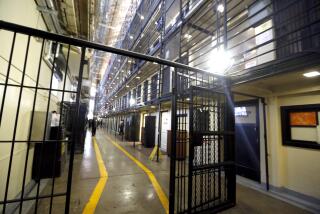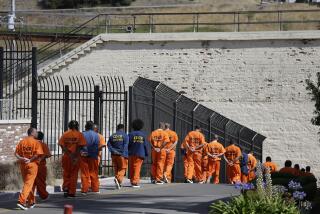California prisons could free 1,000 to ease crowding
SACRAMENTO — Under court orders to ease prison crowding by the end of the year, California officials are scrambling to relocate 9,600 inmates but may be forced to free roughly 1,000 of them before they have completed their sentences.
Officials say most offenders are likely to remain locked up, in privately owned prisons, county jails and other facilities. But some low-level criminals, as well as seriously ill and elderly inmates, could be released, state plans show.
Last week, the U.S. Supreme Court let stand a three-judge ruling that the prisons remain too crowded and inmate numbers must drop. Gov. Jerry Brown has appealed the judges’ order, saying the results could harm public safety, but in the meantime his administration must comply.
Putting inmates on the street would present thorny political problems for Brown, who is widely expected to run for reelection next year and insists that California has done enough to relieve overcrowding.
But “the closer we get to the end of the year, the more difficult it becomes” to avoid releases, Brown’s corrections secretary, Jeffrey Beard, said in an interview.
The state is working on a deal to move hundreds of prisoners to Alameda County jails in coming weeks, and officials are in talks to rent space at a private prison in Kern County. They are considering reopening two low-security detention centers, also in Kern County. Thousands of other inmates would be in firefighting camps or would be confined in other states.
Many of those steps would be costly — and the state would still need to shed about 1,000 more prisoners. So corrections officials and prison medical personnel are reviewing discharge rules and evaluating inmate cases to determine who could be released.
No releases have been scheduled. Officials have not yet detailed all of their plans with the court and are identifying more potential candidates than they may need.
They have already developed new criteria for allowing seriously ill prisoners to be let out. Previously, an inmate needed 24-hour care to qualify; now, officials say, prisoners would no longer have to be bedridden. They could qualify if they have a terminal illness or a severe disability such as Alzheimer’s disease or paralysis.
Those sentenced to death or life without parole would be ineligible, regardless of medical condition.
About 900 inmates meet the new standards for medical release, according to Joyce Hayhoe, a spokeswoman for the court-appointed receiver who runs prison healthcare. But it is unclear how many of their cases could be vetted by the end of the year or how many would be approved by the state parole board.
Thirty offenders at the Central California Women’s Facility near Chowchilla have already been referred to the parole board for consideration. Those prisoners would be released to nursing homes, Hayhoe said, and it is unclear when their cases will be decided.
New rules for paroling elderly inmates are also in the works, according to the state’s court filings. Prisoners could qualify if they are at least 60, have served at least 25 years of their term and are not sentenced to death or life without parole.
Others who could be considered for release are prisoners who committed low-level, nonviolent crimes and are not sex offenders required to register their whereabouts after discharge. The process for releasing them could involve expanding credit for good behavior.
Officials say they’ve identified about 1,200 low-level inmates who have less than a year left in their sentences and are considered less likely than others to commit new crimes.
About 500 similar inmates with more than a year left to serve could also be considered for release. If necessary, other prisoners serving time for minor offenses but who are gang members or committed serious infractions behind bars could also be considered, court papers show.
James Austin, a prison consultant working with lawyers who have sued the state over crowding in its lockups, said that with fewer than five months left to meet the judges’ order, authorities are unlikely to avoid early releases.
“There’s no escaping it now,” he said.
But even high-risk inmates are routinely released when their sentences end, Austin noted. Letting prisoners go a few months ahead of time won’t change their likelihood of reoffending, he said. Beard said he is still hoping to avoid releases altogether, but officials are unsure whether the state can spend money on alternative housing without legislative approval — even though the judges waived any local or state laws that could hamper compliance with their order.
“We have to see what kind of flexibility we have and what kind of capacity we can develop to place people by the end of the year,” Beard said. “There are still some unknowns out there.”
One is how much space can be found in county jails besides Alameda’s. Since October 2011, the state has been diverting low-level felons to jails, rather than send them to state lockups, as a way to reduce the prison population. Many jails are full.
In Los Angeles County, for example, “the sheriff has simply said we can’t handle any more,” said Steve Whitmore, spokesman for Sheriff Lee Baca.
Brown should be building or reopening prisons rather than sending any more inmates to counties, said Abel Maldonado, a Republican former lieutenant governor who may challenge Brown next year and is pushing for a ballot measure to undo some of the governor’s prison policies.
“The governor is completely out of touch if he thinks that he can shift the responsibility of incarcerating and rehabilitating dangerous criminals to local authorities again,” Maldonado said in a statement.
As officials weigh their options, they must also address two other pressing problems.
A separate court order is forcing the transfer of thousands of inmates out of Central Valley facilities where they face high risk of valley fever, a soil-borne fungus. In addition, 346 inmates were refusing meals Wednesday in the fifth week of a hunger strike to protest prison conditions.
The legal and political pressures have put a harsh spotlight on California prisons, long a magnet for controversy.
“The nation is watching,” said San Bernardino County Dist. Atty. Michael Ramos, a critic of Brown’s prison policies. “We better get it right.”
Times staff writer Phil Willon contributed to this report.
More to Read
Start your day right
Sign up for Essential California for news, features and recommendations from the L.A. Times and beyond in your inbox six days a week.
You may occasionally receive promotional content from the Los Angeles Times.







